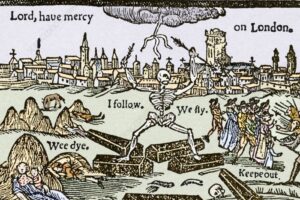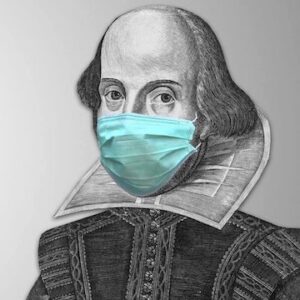Shakespeare’s advice to writers? Use the pandemic (sometimes)
by Nichole DeWallShakespeare’s life was defined by the bubonic plague. What can we learn from the OG of pandemic writers?
Make it count
Today’s writers should deploy our pandemic’s memento mori – face masks, hand sanitiser, refrigerated morgue trucks – sparingly. Overuse lessens impact.
Shakespeare knew this: he reserves images of miasmas (plague-spreading pockets of corrupted air) for moments of heightened dramatic intensity.
Need to terrify at the beginning of Macbeth? Have the Weird Sisters “Hover through the fog and filthy air”. Need to build suspense on the eve of Julius Caesar’s assassination? Make the night “rheumy and unpurged”. Need to pollute the guilty consciences of a fratricidal Danish king and a sleepwalking Scottish queen? Make their sins stink.
click on any image to enlarge and view in slideshow
Because the playhouse smelled, to quote theatre-hating puritan William Prynne, like a “pestiferous Fish-pond”, Shakespeare banked on these images resonating. He read the room.
And remember how apocalyptic lockdown felt at first? Streets stood empty, dolphins swam through Venetian canals, grocery stores became battlegrounds.
Shakespeare’s pandemic conjured up the End Times too, which explains the infected hellscape of King Lear, his bleakest tragedy. When it’s invoked, curses from the usurped King Richard II or the dying Mercutio feel biblical.
When churchyards release their contagion in Hamlet, you can almost hear the final trumpet sounding.
Indulge your audience’s fantasies
What collective fantasies will emerge from our pandemic? Unmasked children skipping cheerfully to school? Unlimited supplies of toilet paper? Fifty Shades of Fauci?
Shakespeare’s audience dreamed of beautiful women who, like Olivia, “purged the air of pestilence”. Juliet’s breath smells of honey; Portia’s of sugar; Imogen’s of perfume; the Dark Lady’s of flowers.

Detail from a recreation of the ‘patriarch and king’ painting from the medieval Dance of Death frescoes on the walls of the Guild Chapel, Stratford-upon-Avon by Wilfred Puddephat, 1950
Shakespeare emulates another pandemic poet, 14th-century sonneteer Francesco Petrarca, who fetishised his beloved Laura’s breath by punning on her name (l’aura).
More poignantly, clearing the air gives Leontes, the jealous tyrant of Sicilia in The Winter’s Tale, a chance at redemption. In the final act, he bestows a blessing on his future son-in-law: “The blessed gods,” he entreats, “Purge all infection from our air whilst you / Do climate here!” A father’s fantasy.
Or just mask the stench. Shakespeare’s at his most rhapsodic when describing Cleopatra’s perfumed barge or Titania’s flower-bedecked bower. We binged Tiger King; they escaped to aromatic worlds where the plague couldn’t harm them.
Rotting bodies strewn across imagined battlefields call up real corpses glutting London’s streets… the skeletal figure of Death is both contained within Shakespeare’s fictive worlds and waiting outside the theatre for the final bow.”
Wait a while
Shakespeare made a rookie mistake when he recounted Friar John’s quarantine in Romeo and Juliet to an audience still reeling from the devastating outbreak of 1592–93. Too soon.
From then on, he played it safe by conflating the plague with lovesickness. Both were contagious, indiscriminate, inflicted by arrows, and transmitted through the eyes. “Even so quickly may one catch the plague?” asks the suddenly-smitten Olivia in Twelfth Night. Love (and plague) at first sight.
Close-but-not-too-close, of course, defined Shakespeare’s work. But the plague is there. Rotting bodies strewn across imagined battlefields call up real corpses glutting London’s streets. Shakespeare’s pastorals evoke wealthy Londoners’ exodus to the country during outbreaks.
And the skeletal figure of Death is both contained within Shakespeare’s fictive worlds and waiting, just outside the theatre, for the final bow.

Contemporary audience at the reconstructed Shakespeare’s Globe, London. Sourav Niyogi / Wikimedia Commons
Show your audience that art heals
There’s a long road ahead for the arts industry. Shakespeare’s advice? Remind audiences why what you do matters.
Melancholy, caused by excess black bile, was lethal. Mirth was the antidote. “Again and again I request you to be merry,” pleads 17th-century melancholy expert Robert Burton. He prescribes the playhouse’s main exports – singing, dancing, poetry, good company and theatrical spectacle – as medicine.
It’s no surprise, then, that Shakespeare doubles down on the restorative power of art. Music fortifies characters and brings them back to life. Fools heal through wordplay. The Taming of the Shrew cures melancholy.
Shakespeare knew – just as fellow plague-time poet Giovanni Boccaccio did in The Decameron – that stories are salubrious, laughter is life-giving.
But it’s shipwrecked wife-turned nun Emilia in The Comedy of Errors who provides Shakespeare’s most pointed reminder of why we need art in a pandemic (and post-pandemic) world:
Sweet recreation barred, what doth ensue
But moody and dull melancholy,
Kinsman to grim and comfortless despair,
And at her heels a huge infectious troop
Of pale distemperatures and foes to life?
The message? Melancholy sickens, “Sweet recreation” saves.
Get thee to a playhouse.
Nichole DeWall is a professor of English at McKendree University, Illinois, where she specialises in Medieval and Renaissance literature, the works of Shakespeare, 17th and 18th Century literature, dramatic literature and English composition. She wrote a doctoral dissertation on Shakespeare and the plague, and has been published in numerous scholarly journals.
mckendree.edu
facebook.com/nichole.dewall.3
@DewallNichole



